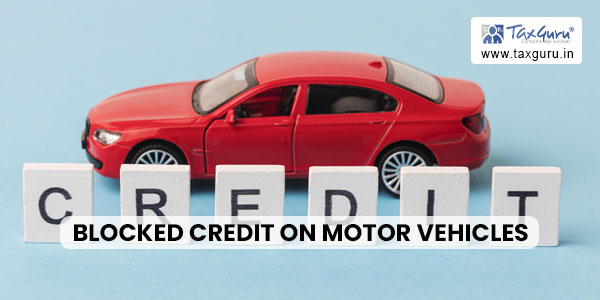Introduction
The Goods and Services Tax (GST) regime has brought about significant changes in the way businesses operate and claim tax credits. However, amidst the multitude of benefits it offers, there are certain scenarios where the availability of Input Tax Credit (ITC) becomes ambiguous. One such area of contention is the eligibility to claim ITC on motor vehicles imported for Research and Development (R&D) purposes. While the law provides certain restrictions under Section 17(5) of the CGST Act, 2017, it inadvertently creates confusion for businesses engaged in R&D, where the imported vehicles are not intended for regular use on Indian roads. This article delves into the issue and seeks to shed light on the challenges faced by companies that import goods for R&D while aiming to use them solely for business purposes.
Understanding the Relevant Provisions
1. Section 16 of the CGST Act, 2017 outlines the eligibility and conditions for taking input tax credit. It states that a registered person is entitled to take credit of input tax paid on any supply of goods and/or services used in the course or furtherance of business. However, this provision is subject to certain conditions, which include possessing valid tax invoices, receipt of goods or services, payment of applicable tax to the government, and filing the relevant returns.
2. However, the availability of ITC under Section 16 is curtailed by Section 17(5) of the CGST Act, 2017. This provision restricts the ITC in specific cases, and one of them is motor vehicles used for transportation of persons, having an approved seating capacity of not more than thirteen individuals. But herein lies the crux of the ambiguity: Are motor vehicles imported for R&D purposes and not intended for regular passenger transportation considered under this restriction?
The Conundrum of R&D Vehicles
1. Businesses engaged in R&D often import motor vehicles to facilitate research, innovation, and product development. These vehicles are primarily intended for technical analysis, testing, and evaluation, and are not meant for regular use on Indian roads due to specific restrictions and regulations. Consequently, they fail to meet the criteria outlined in Section 17(5)(a) of the CGST Act, 2017, which restricts ITC on motor vehicles used for passenger transportation.
2. Importantly, the legislative intent behind blocking ITC on certain motor vehicles seems to be preventing misuse and unwarranted claims. However, this restriction may not have been envisioned for motor vehicles imported solely for R&D activities, which directly contribute to business operations.

Analyzing Legislative Intent
1. To better understand the legislative intent, it is essential to delve into the scope and interpretation of the relevant provisions. Section 17(5)(a) of the CGST Act restricts ITC on motor vehicles used for transportation of passengers with approved seating capacity of not more than thirteen persons. The key terms here are “motor vehicles,” “for transportation of passengers,” and “approved seating capacity.”
2. The definition of “motor vehicle” as per the Motor Vehicles Act, 1988, includes vehicles intended for use on roads. However, R&D vehicles imported for testing purposes lack compliance with road-use regulations, making them ineligible for transportation of passengers.
3. Furthermore, the intention behind importing these vehicles is critical. Since they are not meant for passenger transportation, but rather exclusively for R&D purposes, they should not fall within the purview of Section 17(5)(a) restrictions. Legislative intent often emphasizes preventing misuse, but not at the cost of hindering genuine business endeavors like R&D.
4. The Regional Transport Office (RTO) does not allow driving these vehicles on Indian roads due to their left-hand drive orientation. RTO approval is necessary for any vehicle intended for passenger transportation on Indian roads. However, R&D vehicles, which are imported solely for technical evaluation and testing, do not receive such approvals. Consequently, they remain ineligible for transporting passengers and should not be categorized under the blocked credit list.
5. The law mandates an “approved seating capacity” for blocking ITC on certain motor vehicles. This refers to the maximum number of passengers that a vehicle is authorized or permitted to accommodate, as determined and specified by the relevant regulatory authorities or governing bodies. It represents the officially sanctioned or approved number of seats available for occupants in a vehicle, taking into account safety considerations, space limitations, and other relevant factors.
6. However, R&D vehicles imported for technical analysis may not fall under this category, as they are not intended for passenger transportation on Indian roads. The absence of RTO approvals further solidifies the fact that these vehicles are not meant for transportation of passengers, thereby excluding them from the scope of restriction under Section 17(5)(a) of the CGST Act, 2017.
Clarification Needed for Business Certainty
1. Clarity on the treatment of motor vehicles imported for R&D is essential to provide businesses with a stable and predictable tax environment.
2. Currently, the ambiguity in the law restricts companies from availing legitimate credits on expenses incurred for R&D, creating an unintended financial burden.
The Way Forward
To address this issue and promote ease of doing business, the government could consider the following steps:
1. Clear Definitions: The government can define “R&D vehicles” under GST laws and clearly distinguish them from vehicles intended for regular passenger transportation. This would eliminate the confusion surrounding the applicability of restrictions.
2. Exemptions or Refunds: Providing exemptions or facilitating refunds for specific R&D vehicles can help businesses claim legitimate ITC without administrative hurdles.
3. Advance Rulings: Encouraging businesses to seek advance rulings on the eligibility of ITC for R&D vehicles can bring clarity and reduce disputes.
4. Industry Consultations: Engaging with stakeholders and industry experts to understand their needs and challenges can lead to targeted policy amendments.
Conclusion
The ambiguity surrounding the availability of ITC on motor vehicles imported for R&D purposes poses challenges for businesses and hinders the growth of innovation. The government should consider providing clarity and exemptions to facilitate genuine R&D activities and ensure that companies can rightfully claim ITC on expenses related to research and development. By addressing this issue, the government can foster a conducive environment for R&D-driven growth and innovation in the country.





